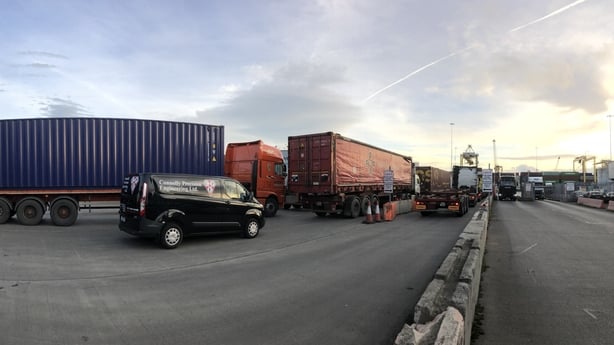With just over two weeks to go before the re-introduction of border controls on goods arriving from the UK, Dublin Port Company said it has completed €30m worth of works to increase the capacity of its internal road network.
It has also introduced new internal traffic management measures to keep traffic flowing through Dublin Port.
The new measures are being introduced this week and will be in full effect in advance of the introduction of the new border controls on January 1, 2021.
But even with additional road capacity and traffic management measures in place, it said that all operators and port users have their part to play to keep trade flowing and ensure that extreme contingency plans are not needed in response to congestion.
This is especially so in the first 90 days of 2021, it cautioned.
As part of Brexit preparations, eight inspection facilities have been constructed for Customs and the Department of Agriculture, Food and the Marine by Dublin Port Company and the OPW at six different locations in Dublin Port.
Dublin is already a busy port and the additional requirement for hauliers to move trailers between ferry terminals and these eight different facilities will increase traffic levels within the port for the same volume of cargo.
Eamonn O'Reilly, CEO of Dublin Port Company, said that since 2018, it has spent €30m to make assets and infrastructure available to OPW to provide border inspection facilities on eight sites covering a land area of 14.6 hectares.
Mr O'Reilly said there is now 16,000 square metres of warehousing with 25 loading bays giving an annual capacity for well over 100,000 physical inspections of containers and trailers.
"There is huge infrastructural capacity in place and the challenge now is to use this capacity efficiently to ensure that goods keep flowing," Mr O'Reilly said.
"There is a simple and obvious measure of success and that is the ability of hauliers to provide their essential services without being delayed in Dublin Port," he added.
"Delays because of Brexit border checks are inevitable, but congestion is not," he stated.

But the Dublin Port CEO said that the closeness in the arrival times of ferries from Holyhead is an obvious cause of concern in January and brings with it the risk of delays being increased to the point of congestion on the road network within Dublin Port.
He said he has asked the two ferry companies operating the Holyhead services to bring the arrival time of the first ship in each of the four daily waves forward and to bring the second ship in somewhat later in order to flatten the demand curve for incoming HGVs.
"In making this request we guaranteed to the ferry lines that they could return to their current slot times at any time during the first 90 days after the new border controls come into place. Disappointingly, one has refused our request and the other has yet to respond," Mr O'Reilly said.
He also said the collection of containers from terminals needs to be scheduled by the container terminal operators, the hauliers and the cargo owners to reduce peaks and prevent excessive queues building on the port's internal road network.
The improvements and changes to Dublin Port are detailed in a new booklet, Six Key Messages for Hauliers.
"To deal effectively with the change required by the new trading environment with Britain after the 31st of December, delivery and collection times will have to be reviewed," agreed Aidan Flynn, General Manager of Freight Transport Association Ireland.
"Ferry timetables will need adjusting to take into account obvious pinch points at Dublin Port when it comes to arrival and departure times to aid the free flow of port traffic; collection and delivery of containers must also be examined to consider likely congestion."
"Government regulatory bodies must ensure that they have the resources available to facilitate the speedy and consistent checks – both documentary and physical – to keep traffic moving and reduce the risk of congestion in the ports."

